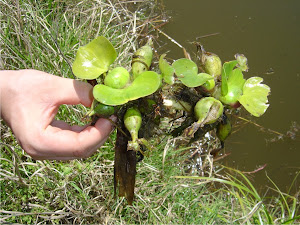Could it be predictable if an alien species will turn into invasive?
Not all invasions evolve in the same way. Their effect and interactions in the new ecosystem are in general unpredictable. Some species could have an explosive demographic growth and their impact becomes apparent in the short term after their arrival in a new place. On the other hand there are other species for which there is a time lag that could even belong many years between the establishment and their evolution into invasive. In spite of steps forward and efforts to detect common patterns in order to determine the invasive potential of a species or the response of a community against a biological invasion, our capacity of prediction is still deficient.
Whose is the problem?
Invasive alien species are prejudicial to all sectors, no-one is exempt. For example, an alien species that turns into an agricultural pest affects the producer, entails costs for authorities (costs for the mitigation) and hits consumers who can’t benefit from the product.
How to face invasive alien species?
CBD Guiding Principles 2: Three-stage hierarchical approach.
1. Prevention is generally far more cost-effective and environmentally desirable than measures taken following introduction and establishment of an invasive alien species.
2. Priority should be given to prevent the introduction of invasive alien species, between and within States. If an invasive alien species has been introduced, early detection and rapid action are crucial to prevent its establishment. The preferred response is often to eradicate the organisms as soon as possible (principle 13). In the event that eradication is not feasible or resources are not available for its eradication, containment (principle 14) and long-term control measures (principle 15) should be implemented. Any examination of benefits and costs (environmental, economic and social) should be done on a long-term basis.
Halting biological invasions is not an easy task because of the multiplicity of entry pathways and their dependence in the kind of introduction. A regulation system based on the Precautionary Approach and a solid inspection system could constitute effective weapons for intentional introductions (those carried out for specific purposes, e.g. the commercial exploitation of a species, landscaping, etc.). On the contrary, the prevention of unintentional introductions requires a deep knowledge of entry pathways and vectors.
The difficulty of halting introductions and minimising the impact of invasive alien species could lead to adopt stances pervaded of pessimism. However many successes in fighting invasive alien species have been achieved in the last years both eradicating species and developing tools to prevent their entry.
The adoption of new systems of inspection has been revealed very effective as well risk analysis permitted to avoid the entrance of invasive species in different occasions and the set up of lists which are, for some countries, a point of reference in order to authorize the entry of an alien species.
However due to a large number of limiting factors (e.g. the volume of transported species and/or goods, the capacity to predict the behaviour of a species in a new ecosystem, etc.) the exclusion of a species is not always possible.
If prevention fails and an alien species gets to a new site, its early detection and eradication become the most suitable management strategy. In this case time is a critical factor because the later occurs the intervention the greater possibilities of establishment and spread will have the new species.
The maintenance of already established species at low population levels is possible by means of different control techniques (mechanical, chemical, biological control) although they could have side effects on the autochthonous biodiversity. In these cases the objective itself (the control of the species) as well as the used method have to be submitted to a cost/benefits analysis.
Nevertheless it has to be taken into account although the use of mitigation techniques (eradication, contention and control) is necessary it meets with a series of obstacles mainly represented by the economic cost and social rejection.
The key of success to halt biological invasions involves the review of policies dealing with the conservation of biodiversity. The reshuffle of institutional and legal frameworks together with the development of national plans consistent with the CBD Guiding Principles and the measures proposed in the European Strategy on IAS, are steps that can’t be postponed. It is necessary to establish and co-ordinate efforts and competences, mobilize adequate human and economic resources and ensure their availability in the time.
Prevention is with no doubt the most effective strategy in the long-term. The fight against invasive alien species can’t be a task exclusive to the administration (border and quarantine officers). It requires the involvement of all stakeholders (trade sectors, hunters, fishermen, public, etc.) who get benefits (in the broad sense of the term) from the use of alien species. With this aim it is necessary to sensitize the above mentioned sectors and develop codes of best practices which application could become an usual habit.
The GEIB Grupo Especialista en Invasiones Biológicas (ex GEI Grupo Especies Invasoras) is a nationwide independent organization developing its own projects and providing technical assistance and consultancies in the field of biological invasions.

Headquarters: C/Tarifa 7, E-24193 Navatejera (León), Spain. E-mail: geib.org@gmail.com // geib.uc@gmail.com
Blog Archive
-
▼
2007
(15)
-
▼
11
(15)
- Spanish - Castellano
- NEWS
- FACTS
- GREEN ALLIANCE
- "EEI 2006" 2nd NATIONAL CONFERENCE ON INVASIVE ALI...
- GOALS
- The TOP 20. The 20 worst invasive alien species pr...
- BASIC CONCEPTS
- FAQ ON IAS
- WHAT YOU CAN DO TO PREVENT BIOLOGICAL INVASIONS
- INVASORAS E-LIST
- LINKS OF INTEREST
- DOCUMENTS OF INTEREST
- ABOUT US
- CONTACT US
-
▼
11
(15)
LET"S COOPERATE AMONG NGOs

A space for environmental cooperation
Acacia melanoxylon

Photo: GEIB (L. Capdevila-Argüelles)
Arctotheca calendula

Photo: GEIB (L. Capdevila-Argüelles)
Buddleja davidii

Photo: Forest & Kim Starr
Carpobrotus edulis

Photo: GEIB (L. Capdevila-Argüelles)
Cortaderia selloana

Photo: Forest & Kim Starr
Eichornia crassipes

Photo: GEIB (L. Capdevila-Argüelles)
Hedychium gardnerianum

Photo: Forest & Kim Starr
Eucalipto

Photo: GEIB (L. Capdevila-Argüelles)
Miconia calvescens
Photo: Forest & Kim Starr
Opuntia ficus-indica

Photo: Forest & Kim Starr
Oxalis purpurea

Photo: GEIB (L. Capdevila-Argüelles)
Oxalis purpurea

Photo: GEIB (L. Capdevila-Argüelles)